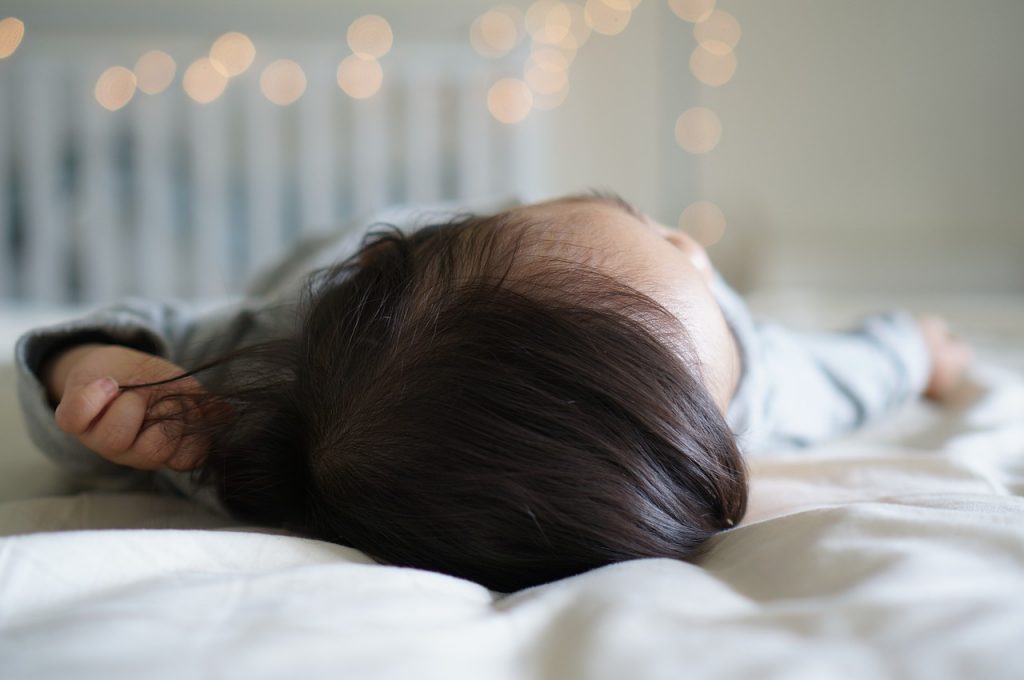Let me start by saying that I know that sleep training can spur a lot of feelings and opinions. This post is by no means telling you what you should or shouldn’t do, but simply sharing my own experience with sleep training. Do whatever is best for you and your child, what feels right for your family, and if the idea of sleep training triggers you, feel free to click away now. However, if you’re curious what it’s like to sleep train a baby and how life-changing it can be, keep reading!
The newborn phase is a grind. Between balancing feedings, diaper changes, and getting adequate sleep, it can feel like you’re on a hamster wheel, going nowhere fast. It’s beautiful and wonderful, but it’s also really hard. There were so many things that I had forgotten about the newborn phase, even though my son is just two-and-a-half years old. I went through this fairly recently! I should have remembered.
That’s the thing about parenthood. You tend to remember all the good stuff and all the “bad” and “hard” stuff? You quickly forget once you’re past it.
And it’s extra hard when your baby won’t sleep.

Baby won’t sleep
My daughter was about four weeks old when her lack of sleeping started to get to me. It was probably the mix of postpartum hormones, multiple night wakings, night feedings, and then rocking back to sleep, on what felt like an endless loop that was starting to drive me crazy. I did not have one of those magical “unicorn babies” (as I like to call them) who just fell asleep with ease.
We sleep trained our son and the results were glorious. While the actual “learning” period can be difficult, the ability to put your baby down for sleep without assistance is so life-changing. I knew that we had to wait until she was four months old for sleep training because newborns are not able to self soothe yet. I understood that, so I persevered through all the crappy naps and less-than-restful nights.
I’d be lying if I said that I wasn’t looking forward to sleep training. I’ve been savoring the newborn season, but also, waiting for it to end. Because underneath it all, I really needed an hour to myself. One magical hour where both the infant’s and the toddler’s naps overlapped so mama could catch at least one break a day.
What is infant sleep training?
Before I had children, I had never heard of infant sleep training. Once I was expecting my son, a friend and fellow mom told me about sleep training. She told me how she had sleep trained her daughter and how it just made life so much easier.
That being said,sleep training is essentially teaching your baby to fall asleep independently. The goal is to be able to set your baby in their crib for night sleep or a nap and they fall asleep on their own. No more rocking, bouncing, swaying your baby to sleep.
I think sleep training tends to get a bad rep because many people assume that you’re letting your baby cry it out for hours on end. In other words, some people think you’re putting the baby in their crib, shutting the door, and walking away until morning. While this method is an option, it definitely was not an option for me.
The sleep training method I used is typically called “modified” cry it out, meaning that you set the baby down and check in on them in timed intervals until they fall asleep.
How to sleep train your baby
Do your research. Talk to your pediatrician about sleep training. Talk to your pediatrician about if you need to continue feeding at night. Talk to your spouse and other caretakers involved, such as daycare, nanny, grandparents. Decide what method you’d like to follow for sleep training.
Personally, I followed the methods from The Sleep Easy Solution book that a friend recommended. I started to re-read the book (we used the same book for my son) and remembered the process for sleep training.
When my daughter turned four months old, we decided to go for it that weekend. We had been “practicing” using the crib for naps. So on that Friday night we prepared her room, we prepared ourselves, and honestly, said a little prayer.
The Modified CIO Sleep Training method
The first night of sleep training, you’ll do your typical bedtime routine—pajamas, diaper change, bedtime feeding (without falling asleep), read books, etc.
After that, put your baby in their sleep sack, say, “night night”, give kisses, turn on the white noise, and set your baby down in the crib.
Turn off the light and walk out of the room.
Set a timer for five minutes.
Take a deep breath if your baby begins to cry. You get to check on them in just five minutes. Those five minutes might feel like an eternity but resist the urge to run back into your baby’s room.
When the timer is up, and if your baby is fussing or crying, open the door, say something like, “You’re doing a great job! I love you! Goodnight!” and stay no longer than 30 seconds. Then, leave the room.
Set a timer for 10 minutes.
After 10 minutes is up, if your baby is still awake, check in again, just like the first check-in.
Set a timer for 15 minutes.
You’ll continue this cycle of 15-minute checks until your baby falls asleep.
Starting on Day 2, you’ll do this process for naps as well.
Sleep training is pretty straightforward. What can make it difficult is the emotional toll it may take on you, the parent. Listening to your baby cry for any amount of time tugs on your heartstrings. But once they learn how to fall asleep on their own, it’s game-changing.
 Sleep training results
Sleep training results
As of this post, it has been about a month since we sleep trained our daughter. She sleeps most nights from 8pm to 7am. It’s amazing. She wakes up every morning with a big smile on her face.
I’ll be honest, though. The first night was definitely the hardest. She fell asleep initially after about 30 minutes and slept for about two hours straight. Then she woke up again around 10:30pm and didn’t settle down until almost midnight.
The second night, I expected more of the same. However, during the day we started sleep training for naps as well and by the end of the day, she fell asleep in just 10 minutes for nighttime sleep.
By the third night, she was falling asleep in just about five minutes for naps and bedtime! Amazing!
Now when she wakes up in the middle of the night she can put herself back to sleep in a matter of minutes. Of course, if she starts crying in the middle of the night, I go check in on her in the timed intervals as stated previously.
Sleep Training Benefits for the Family
Sleep training has been great for the whole family. My husband and I finally get to spend time together after the baby and the toddler go to bed. It’s like we suddenly have time to spend just the two of us, without competing with the attention of a toddler and the needs of an infant.
It’s been great for our toddler because when it’s the baby’s nap time, I’m not spending 20 minutes trying to get her to go to sleep. In fact, now he can help with nap time by helping read books and turning on the white noise. Now that the baby is sleep trained, we get to spend more time together.
Sleep training saved my sanity. There were moments in the first three months where my baby’s lack of sleep started to grate on my nerves. I felt like I had random bursts of anger and frustration. I’m sure it was a mix of hormones and lack of sleep.
Now that she is sleep trained, I get to sleep at night, too. I feel well-rested and ready to take on the day. I’m happy to see her in the morning, feeling confident that she’s going to get good sleep. When I put her down for naps, it’s incredibly freeing to know that I just have to set her in her crib, turn on the white noise, turn off the lights, and walk out.
Again, I know that sleep training is a completely personal choice. For me, it was a choice that saved my sanity and has made me a much happier and present parent.
More Baby Sleep Resources
:: 9 Tips & Tricks for Sleep-Deprived Parents ::
Baby Sleep Instagram Accounts
Each of these sleep consultants also have courses on sleep training for your baby or toddler.













